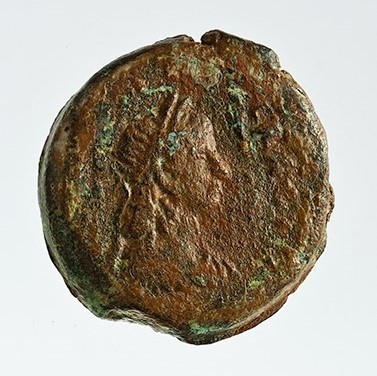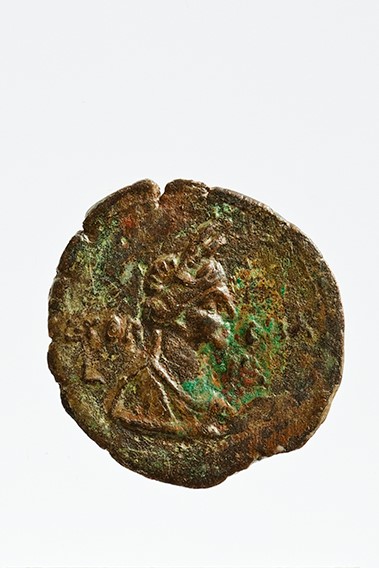Title: Diobol of Agrippina the Younger, reign of Claudius - 1967.22
Acquisition number: 1967.22
Author or editor: Beryl Rawson
Culture or period: Roman Imperial
Date: AD 51-52
Material: Metal - Bronze
Object type: Coins - Roman
Dimensions: 25mm (w)
Origin region or location: Egypt
Origin city: Alexandria
Display case or on loan: 5
Keywords: Coin, diobol, Roman, Imperial, Claudius, Agrippina the Younger, Euthenia, Roman Egypt, Alexandria
Burnett, A., Roman Provincial Coinage (London, British Museum Press, 1992) I, Alexandria, 5186;Poole, R.S., (ed.), A Catalogue of the Greek Coins in the British Museum (London, The British Museum, 1873-1927; repr. Bologna 1963-1964) Alexandria and the Nomes no. 108.
1967.22
Diobol of Agrippina the Younger, reign of Claudius
10.803 g. AD 51-52
Obv.: Bust of Agrippina the Younger r., wreath of grain-ears round head, hair in chignon on neck. AΓPIΠΠINA CEBACTH (almost illegible).
Rev.: Bust of Euthenia r., crowned with grain-ears; hand holds ears of grain. In field, EYΘH–NIA. LIB.
Minted in Alexandria. The inscription on the obverse is the Greek form of ‘Agrippina Augusta’. That on the reverse gives the name Euthenia and the date. The date is ‘the twelfth year’ (of Claudius’ reign), i.e. between August AD 51 and August AD 52.
Both Agrippina and Euthenia wear the attributes of Demeter, symbolising the grain production of Egypt. Euthenia is the personification of Abundance. She became identified as the consort of the god Nilus.
Agrippina received the title ‘Augusta’ in AD 50, on the occasion of Claudius’ adoption of her son Nero. She was the first woman to bear this title in her husband’s lifetime.
Burnett, A., Roman Provincial Coinage (London, British Museum Press, 1992) I, Alexandria, 5186;Poole, R.S., (ed.), A Catalogue of the Greek Coins in the British Museum (London, The British Museum, 1873-1927; repr. Bologna 1963-1964) Alexandria and the Nomes no. 108.

